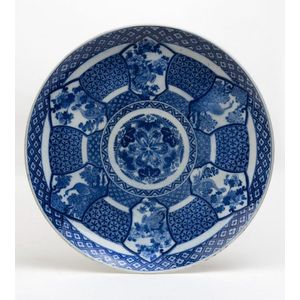Meiji Blue & White Charger with Floral & Bird Motifs
A Meiji period blue and white charger, Japanese, circa 1900, the central flower decoration surrounded with panels of peacocks, cranes and swans, blue and white wave marks to the underside, 46 cm diameter
You must be a subscriber, and be logged in to view price and dealer details.
Subscribe Now to view actual auction price for this item
When you subscribe, you have the option of setting the currency in which to display prices to $Au, $US, $NZ or Stg.
This item has been sold, and the description, image and price are for reference purposes only.
- Circa - A Latin term meaning 'about', often used in the antique trade to give an approximate date for the piece, usually considered to be five years on either side of the circa year. Thus, circa 1900 means the piece was made about 1900, probably between 1895 and 1905. The expression is sometimes abbreviated to c.1900.
- Charger - A charger is a type of large plate, typically used as a decorative base for smaller plates or bowls. They are often used in formal settings, such as at a banquet or a special occasion.
The history of chargers can be traced back to medieval times, when they were used as a base for serving dishes in banquet settings. They were typically made of metal, such as silver or pewter, and were highly decorative, often featuring intricate engravings or designs.
During the Renaissance period, chargers began to be made of porcelain, and their designs became more ornate. They were often used in the homes of the wealthy and were considered a symbol of wealth and status.
In the 18th and 19th centuries, chargers were produced in great numbers by European porcelain manufacturers, and they were exported to America and other parts of the world. They were highly sought after by the upper class and were often used as a decorative element in formal table settings.
This item has been included into following indexes:
